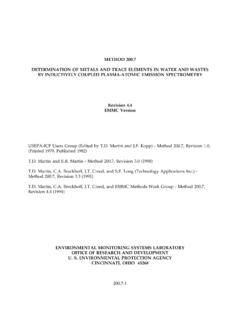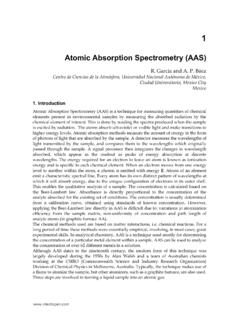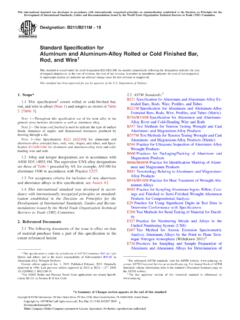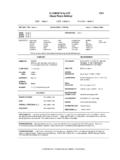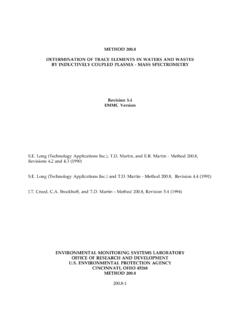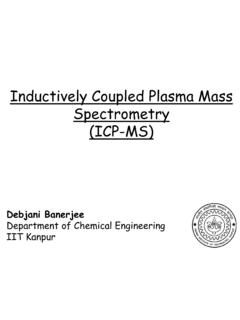Transcription of Forensic Analysis of Glass - Mrs. Milligan-Joye's Classroom
1 Kathy Mirakovits, FSEC1 Forensic Analysis of GlassKathy MirakovitsForensic Science Educational Consulting, LLCK athy Mirakovits, FSEC2 Glass An amorphous solid In pure form is made up of silicon and oxygen molecules: Silicon Dioxide- SiO2 High melting point - over 2000 0C Hard & brittle like a solidKathy Mirakovits, FSEC3 Types of Glass Float Glass or soda lime Glass -windows, picture frames, flat Glass objects SiO2 with sodium carbonate (Na2CO3and calcium oxide CaO) Tempered Glass - safety Glass , auto Glass , shower doors and plate Glass windows in store Same chemical makeup as soda lime Glass , but top layer is cooled first causing internal stresses. When broken this Glass fractures into small blunt Mirakovits, FSEC4 Types of Glass Borosilicate Glass - lab glassware, kitchen items (Pyrex) SiO2 with Boron Tinted Glass - has colorants that reduce glare / heat penetration or for decorative use SiO2 with additives/colorants Leaded Glass (crystal)- wine glasses, fine dining, figurines SiO2 with lead oxideKathy Mirakovits, FSEC5 Glass as Forensic Evidence Glass is forensically important It is found at most crime scenes It can be carried away from scene undetected It is stable, does not decay As class evidence contributes to the pool of evidence Important to collect proper known samples so incidental Glass can be eliminatedKathy Mirakovits, FSEC6 Fracture MatchThe vertical white lines are stress marks in twoeyeglass lenses.
2 Notice how the stress marks align, an individual characteristic. Glass generally classevidence, except when a fracture match is found, which is considered to be an individualcharacteristic Microscopic characteristics can assist in making decision about suspected match Random stress patterns and breaks are uniqueReassembled Molotov CocktailKathy Mirakovits, FSEC7 Analyzing Broken GlassAnalyzing Broken Glass Broken Glass Analysis is forensically important to the reconstruction of events in a criminal act Analysis can include: The sequence of the fractures order of events The direction of the force which caused the fracture did the break occur from the inside or outside The identity (type) of a small piece of Glass soda lime Glass , borosilicate, tempered, or lead crystalKathy Mirakovits, FSEC8 Sequencing Fractures Fracture lines: Radial and Concentric Radial fracture lines occur first extending outward from the break point, produced when the opposite side of impact fails first Concentric fracture lines form a circle about the break point and are produced by the side of impact failing firstABRadial FracturesConcentric FracturesKathy Mirakovits, FSEC9 Sequencing Fractures Radial lines always end in existing radial lines Order in photo: A then B then CABCK athy Mirakovits, FSEC10 What Are The Possible Fracture Sequences?
3 ABCDEIt can be noted:B was firstC was after E E was after AD was after BPossible Sequences:B, D, A, E, CB, A, D, E, CB, A, E, D, CB, A, E, C, DKathy Mirakovits, FSEC11 Direction of Force Small projectiles entry-exit Entry: smaller hole, smooth surface Exit: wider hole, crater shape, rough surface Radial fractures indicate direction of force 3 RRule: Radial fracture Right angle Reverse side of forceEntry HoleExit HolecrateringRight Angle sideForce came from this sideKathy Mirakovits, FSEC12 Class Characteristic of Glass Class characteristics of Glass are limited because Glass is so inert difficult to dissolve in solvents Exception is the inductively coupled plasma Mass Spectrometer (ICP/MS) digests Glass and performs elemental Analysis to determine chemical composition ICP/MS in few crime labs Most labs can analyze class characteristics: Physical appearance size, shape, thickness Color Density Refractive indexKathy Mirakovits, FSEC13 Measuring The Density Of A Small Piece of Glass1.
4 Mass the piece of Find Volume of Tare beaker with Tie thread around SUSPEND the Glass in Take mass Mass of water displaced = Volume of water displaced =Volume of piece of Calculate density of the Glass g/mlPyrex Glass g/mlLeaded Glass g/ml Kathy Mirakovits, FSEC14 Refractive Index Refractive Index (RI) is the ratio of the velocity of light in avacuum to it s velocity in a medium Equation: RI = c/vmediumc = 3 x 108m/s As light passes from one medium to a different medium, it changes speed, causing it to bend or refractThe straw appears bent due to refraction of lightKathy Mirakovits, FSEC15 Refractive Index Determination of a Small Glass Fragment Refractive index of small pieces of Glass can be determined using commercially available liquids whose refractive indexes are knownABCP hoto A shows a small piece of Pyrex Glass not immersedin a liquid. Photo B shows the same piece of Glass immersed in water. Photo C shows the piece immersed in vegetable oil.
5 Pyrex and vegetable oil have similar indices of refraction as shown by the disappearance of the Glass in the Mirakovits, FSEC16 Refractive Index Determination of a Small Glass FragmentGlass TypeRIWindow Glass (soda lime) Glass (auto) Glass (29%-55%) Mirakovits, FSEC17 Measure the RI of Comparison Liquids Use plastic dishes filled with liquid to be tested Laser light or light box single beam through liquid at a given angle (300). Trace refracted beam. Calculate RI using Snell s Lawn1= n2(sin 2) / sin 1n2= (air)

